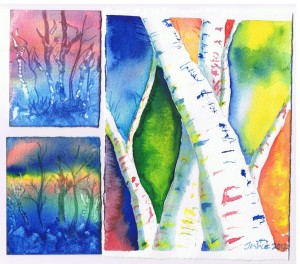 At left is a triptych I painted yesterday in a class in Beginning Watercolors. I am not posting this art work to “show it off” (although I am proud of it as a first effort). I’m posting it because it illustrates a point I’d like to make about Plotting versus Pantsing.
At left is a triptych I painted yesterday in a class in Beginning Watercolors. I am not posting this art work to “show it off” (although I am proud of it as a first effort). I’m posting it because it illustrates a point I’d like to make about Plotting versus Pantsing.
If you have attended writers conferences those terms – plotting and pantsing – will be familiar to you. If not, here’s what they mean: writers who plot their novels carefully and then begin writing are called Plotters; writers who “just sit down and write” are called Pantsers (because they are writing “by the seat of their pants” – i.e., “by feel or instinct, without formal guidelines“).
If you’ve read my earlier post on the role of inspiration in writing, you’ll recognize that Pantsers better fulfill the romantic vision of how a writer works. And Pantsing is a perfectly acceptable way to write.
But there is one great drawback to Pantsing: it’s inefficient.
It’s very easy for a writer to write herself into a corner when Pantsing. At some point, several Scenes or Chapters in, she reads what she’s written so far and realizes the Story is not working. And more often than not, the Story is not working because the Structure is faulty – resulting in a lack of Story tension and pacing, faulty Story logic, etc. That means lots of wasted effort and lots of rewriting – until the Story “feels” right.
Again, it’s fine to work this way. But it’s much more efficient to be a Plotter. (See previous posts on Step One, Two, Three, etc.)
Nor does being a Plotter mean that you eschew Inspiration – and that exhilirating feeling of entering a story world that takes on a life of its own. I’ve found that, once I start writing, even following my beat sheet outline, the Story and the Characters constantly surprise me. But I also find that, having the Beat Sheet to work from, speeds my trajectory to the completion of that all-important solid first draft.
So where do my watercolors fit in? Well, I knew a little bit about watercoloring before I took the class in which I painted the triptych. But I never would have known how to produce the paintings above. In that first 3-hour class, the instructor made that possible by showing us the techniques involved: how to paint a wash; how to use a flat brush, a round brush, a rigging brush, and a palette knife to get certain effects; how to paint wet on wet, wet on dry, and dry on dry; how to blend color; how to create tree and boulder and sunset effects; and, for the large painting, how to sketch tree trunks.
We then sketched and painted original compositions. I know I never would have painted three (to me, pleasing) drawings in three hours without this knowledge of technique. Like Plotting, technique in watercolor not only speeds up creativity, it allows you to create effects you might otherwise never be able to achieve.
Happy Writing!

No Comments